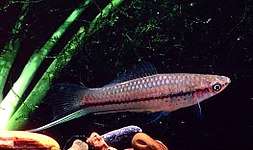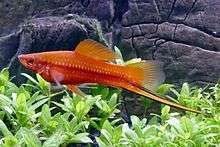Green swordtail
The green swordtail (Xiphophorus hellerii) is a species of freshwater/brackish fish in family Poeciliidae of order Cyprinodontiformes.[2] A live-bearer, it is closely related to the southern platyfish or ‘platy’ (X. maculatus) and can crossbreed with it. It is native to an area of North and Central America stretching from Veracruz, Mexico, to northwestern Honduras.
| Green swordtail | |
|---|---|
 | |
| Male | |
| Scientific classification | |
| Kingdom: | Animalia |
| Phylum: | Chordata |
| Class: | Actinopterygii |
| Order: | Cyprinodontiformes |
| Family: | Poeciliidae |
| Genus: | Xiphophorus |
| Species: | X. hellerii |
| Binomial name | |
| Xiphophorus hellerii Heckel, 1848 | |
Description

The male green swordtail grows to a maximum overall length of 14 centimetres (5.5 in) and the female to 16 centimetres (6.3 in). The name ‘swordtail’ is derived from the elongated lower lobe of the male's caudal fin (tailfin). Sexual dimorphism is moderate, with the female being larger than the male, but lacking the ‘sword’. The wild form is olive green in color, with a red or brown lateral stripe and speckles on the dorsal and, sometimes, caudal fins. The male's ‘sword’ is yellow, edged in black below. Captive breeding has produced many color varieties, including black, red, and many patterns thereof, for the aquarium hobby.
The green swordtail prefers swift-flowing, heavily vegetated rivers and streams, but is also found in warm springs and canals. Omnivorous, its diet includes both plants and small crustaceans, insects, and annelid worms.
Invasive species
X. hellerii has become a nuisance pest as an introduced species in a number of countries. It has caused ecological damage because of its ability to rapidly reproduce in high numbers. Feral populations have established themselves in southern Africa, including Natal, Hawaii, Madagascar and eastern Transvaal in South Africa and Otjikoto Lake in Namibia. Significant populations have also established themselves along the east coast of Australia.
Etymology and taxonomy
The binomial of the green swordtail is made up of its generic name, Xiphophorus which means sword bearer in Greek, a reference to the extended lower part of the caudal fin which is referred to as the "sword". The specific name honours the collector of the type, the Austrian botanist Karl Bartholomaeus Heller (1824-1880), who discovered this fish while exploring México in 1845-1848.[3] The green swordtail was described from Heller's type by Johann Jakob Heckel in 1848 with the type locality given as Orizaba, Mexico.[4] It is the type species of the genus Xiphophorus.[5]
Aquarium Fish
One of the most popular tropical aquarium fish, the green swordtail has been bred into various hybrid forms for the aquarium hobby due to its hardiness and suitability for community tanks.
X. hellerii is a common laboratory animal and has been used as a model organism in studies involving female mate preference[6] and male conflict.[7]
It is often designated X. helleri (with one ‘i’), but authorities consider this an orthographic error and the spelling with two ‘i’s to be the valid specific epithet. It is named after Karl Bartholomaeus Heller, who collected the type specimen. Due to interbreeding with the southern platyfish or ‘platy’, most swordtails in aquariums are hybrids to some degree.
The males’ elongated caudal fins have been found to significantly affect their chances at mating. The presence of a well-endowed male spurs the maturity of females, while it inhibits the maturity of juvenile males in the vicinity of the well-endowed male.[8][9][10]
Gallery
- Cultivated form of X. hellerii
 Fry
Fry
References
- Daniels, A. & Maiz-Tome, L. (2019). "Xiphophorus hellerii". IUCN Red List of Threatened Species. 2019: e.T191780A2002911. doi:10.2305/IUCN.UK.2019-2.RLTS.T191780A2002911.en.
- Froese, Rainer and Pauly, Daniel, eds. (2013). "Xiphophorus hellerii" in FishBase. November 2013 version.
- Christopher Scharpf; Kenneth J. Lazara (26 October 2019). "Order CYPRINODONTIFORMES: Families POECILIIDAE, ANABLEPIDAE, VALENCIIDAE, APHANIIDAE and PROCATOPODIDAE". The ETYFish Project Fish Name Etymology Database. Christopher Scharpf and Kenneth J. Lazara. Retrieved 8 November 2019.
- Eschmeyer, W. N.; R. Fricke & R. van der Laan (eds.). "Xiphophorus helleri". Catalog of Fishes. California Academy of Sciences. Retrieved 8 November 2019.
- Eschmeyer, W. N.; R. Fricke & R. van der Laan (eds.). "Xiphophorus". Catalog of Fishes. California Academy of Sciences. Retrieved 8 November 2019.
- Basolo, Alexandra L. (1990-08-01). "Female preference for male sword length in the green swordtail, Xiphophorus helleri (Pisces: Poeciliidae)". Animal Behaviour. 40 (2): 332–338. doi:10.1016/S0003-3472(05)80928-5.
- Beaugrand, Jacques; Goulet, Claude; Payette, Daniel (1991-03-01). "Outcome of dyadic conflict in male green swordtail fish, Xiphophorus helleri: Effects of body size and prior dominance" (PDF). Animal Behaviour. 41 (3): 417–424. doi:10.1016/S0003-3472(05)80842-5.
- "In the science of sexual attraction, size matters". Yahoo! Science News. Yahoo! Inc. 2007-02-13. Archived from the original on 2007-02-16. Retrieved 2007-02-14.
- Choi, Charles Q. (2007-02-13). "Male Bling Makes Female Fish Mature Faster". LiveScience Animaldomain. Imaginova Corp. Retrieved 2007-02-14.
- Choi, Charles Q. (2007-02-13). "Male Bling Makes Female Fish Mature Faster". Yahoo! Science News. Yahoo!, Inc.
External links


- Froese, Rainer and Pauly, Daniel, eds. (2004). "Xiphophorus hellerii" in FishBase. October 2004 version.
- "Xiphophorus hellerii". Integrated Taxonomic Information System. Retrieved 9 December 2004.
- Xiphophorus maculatus (Spanish)
- Xiphophorus hellerii profile with photographs of various strains on Fishes N Inverts
- Xiphophorus hellerii gallery with photographs of various strains on Fishes N Inverts

